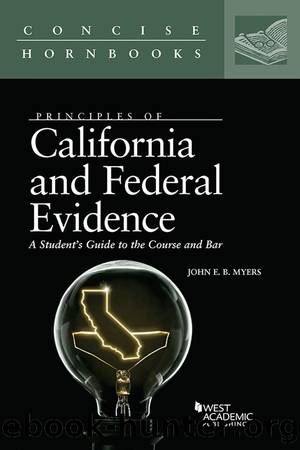Principles of California and Federal Evidence, A Student's Guide to the Course and Bar (Concise Hornbook Series) by Myers John

Author:Myers, John [Myers, John]
Language: eng
Format: epub
Publisher: West Academic
Published: 2017-08-12T00:00:00+00:00
§ 11.11(a). â Past Recollection Recorded on the California Bar
In 2012, the California bar tested recollection recorded, among other issues. Here is part of the question, reprinted with permission from the California State Bar:
Paul sued David in federal court for damages for injuries arising from an automobile accident. . . . In his case-in-chief, David testified that Paul was speeding, lost control of his car, and ran into him. David called Molly, who testified that, on the day of the accident, she had been driving on the highway, saw the aftermath of the accident, stopped to help, and spoke with Paul about the accident. She testified further that, as soon a Paul was taken away in an ambulance, she carefully wrote down notes of what Paul had said to her. She testified that she had no recollection of the conversation. David showed her a photocopy of her notes and she identified them as the ones she wrote down immediately after the accident. The photocopy of the notes was admitted into evidence. The photocopy of the notes stated that Paul told Molly that he was at fault because he was driving too fast and that he offered to pay medical expenses for anyone injured. David rested his case. Assuming that all appropriate objections and motions were timely made, should the court have admitted: . . . 2. The photocopy of Mollyâs notes? Discuss. Answer according to the Federal Rules of Evidence.
This question raises the following issues: (1) Relevance. Relevance is easy because Paulâs statement couldnât be more relevant: It is an admission of responsibility! (2) Authentication. Because a document is being offered, it must be authenticated. Molly can do this because she wrote it, and remembers writing it. (3) Best Evidence Rule. David is trying to prove the contents of a writing, so the best evidence rule applies. A photocopy is a duplicate, and duplicates are admissible to the same extent as an original, unless there is reason to be concerned about the correctness of the duplicate, which there does not appear to be here. (4) Layered hearsay. The original (first) layer is Paulâs statements to Molly, which is admissible against Paul as a personal admission. The final (second) layer is Mollyâs note, which is admissible as past recollection recorded. (5) Paulâs offer to pay medical expenses is excluded by FRE 409 (See § 2.23). It is an offer to pay medical expenses resulting from an injury, and is not admissible to prove liability for the injury. (6) Do you need to mention competence to testify (FRE 601 ) and the danger of unfair prejudice (FRE 403 )? The
200
witness is an adult. There does not seem to be any reason to discuss testimonial competence. Nor is there a need to discuss the danger of unfair prejudice because there is nothing unfairly prejudicial about this evidence. Your professor may want you to discuss competence and the danger of unfair prejudice. The bar prep courses encourage you to discuss unfair prejudice every time you discuss relevance.
Download
This site does not store any files on its server. We only index and link to content provided by other sites. Please contact the content providers to delete copyright contents if any and email us, we'll remove relevant links or contents immediately.
Mastering Civil Procedure, Third Edition (Mastering Series) by David Charles Hricik(233)
Injury Illustrated: How Medical Images Win Legal Cases by R. Annie Gough(216)
Crush Debt Now!: A 3-step Negotiation Strategy to pay off debt and win financial freedom fast (Personal finance wizard series Book 2) by Cromwell Tom(201)
The Role of the Highest Courts of the United States of America and South Africa, and the European Court of Justice in Foreign Affairs by Riaan Eksteen(183)
The Court of Arbitration for Sport and Its Jurisprudence by Johan Lindholm(172)
Weak Courts, Strong Rights by Tushnet Mark(170)
Principles of California and Federal Evidence, A Student's Guide to the Course and Bar (Concise Hornbook Series) by Myers John(168)
Federal Rules of Civil Procedure with Resources for Study 2021-2022 by Subrin Stephen N. & Minow Martha L. & Brodin Mark S. & Main Thomas O. & Lahav Alexandra D(164)
